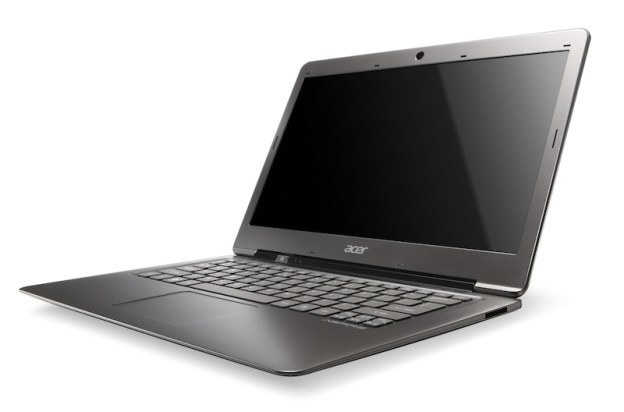
Although it hasn’t exactly been a secret, Taiwan’s Acer has officially unveiled its super-slim Acer Aspire S3 Ultrabook, the first in the company’s series of Ultrabook systems. Like any good Ultrabook, the sleek Aspire S3 puts an emphasis on portability and performance: it packs a second-generation Intel Core i5 processor, measures barely over half an inch thick, and weighs under three pounds. And the Aspire S3 is also promising long battery life: Acer says the unit will run for six hours on a single charge, and offers an impressive 50-day standby time.
“The combination of extreme mobility and affordability found in the Acer Aspire S3-951 Ultrabook will undoubtedly change the way people think about mobile computing,” said Acer America’s VP of product marketing Sumit Agnihotry, in a statement. “Consumers are going to love the value they find in the freedom and capabilities it offers.”
The Aspire S3 Ultrabook features a second-generation “Sandy Bridge” Intel Core i5 processor running at 1.6 GHz, although Turbo Boost technology can take it up to 2.3 GHz for performance sprints. The system offers a 13.3-inch 1,366 by 768-pixel LED-backlit display driven by the CPU’s integrated Intel HD graphics 3000 graphics processor and ships with a standard 4 GB of RAM. Inside the super-slim chassis, the Aspire S3 packs a 320 GB 5,400 rpm hard drive supplemented by a 20 GB solid-state drive—the idea is to pack the operating system and the machine’s current state onto the SSD, leaving the hard drive for applications, documents, and media. Combined with Acer Green Instant On technology, the Aspire S3 wakes from sleep in just two seconds, and can jump back on the Internet in as little as 2.5 seconds, letting folks get back to work—or at least Facebook—in record time.

The Aspire S3 sports a rigid frame made from magnesium aluminum alloy, featuring a metallic silver smudge-resistant finish: even though it’s very thin, Acer says the chassis is strong enough to protect the display. Most of the ports (HDMI and VGA output, power, and 2 USB 2.0 jacks) are located on the back of the unit, although the 2-in-1 card reader and headphone jack are on the sides. The Aspire S3 also sports a 1.3 megapixel webcam along with 802.11b/g/n Wi-FI, and Bluetooth 4.0+HS wireless networking—of course, the system also supports a range of Acer technologies, including clear.fi media sharing. The unit measures 12.59 by 8.52 inches wide and deep, and ranges from 0.51 to 0.69 inches in height. At just 2.98 pounds, the system lives up to the Ultrabook promise of portability.
The Aspire SE-951 will be available October 16 at U.S. and Canadian retailers for a suggested price of $899.99. Acer expects to roll out future Ultrabook models with Core i3 and Core i7 processors as well as more expansive storage options, but there’s no word on date or pricing.
What’s missing from the Aspire S3? Roughly, all the usual things you can expect to be missing in any Ultrabook: there’s no optical drive, no USB 3.0 or Thunderbolt (those will probably have to wait for Ultrabooks based on Intel’s forthcoming “Ivy Bridge” processors), and don’t expect to swap out the battery when you’re on the road: it’s “integrated.” But if you’re after power and portability in a Windows notebook—there are worse systems to consider.


